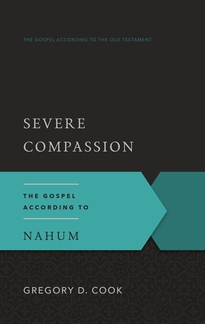Here is an excerpt taken from our new release, Severe Compassion: The Gospel According to Nahum by Gregory D. Cook.
AN ORACLE CONCERNING NINEVEH
The first words of Nahum identify the book as an oracle. Nahum uses a Hebrew word that refers to a specific type, or genre, of prophecy. All the prophetic passages described as oracles declare the historical fulfillment of previous prophecies. Since the first verse describes the entire book as an oracle, we know that Nahum’s words will declare the fulfillment of promises spoken by earlier prophets.
The next two words establish the subject of this prophecy. The book concerns Nineveh, the capital city of the Assyrian Empire. Nineveh had not always been Assyria’s capital. For most of Assyria’s history, the city of Asshur filled this role. Nineveh was an ancient city mentioned in Genesis 10:11, but it had limited importance to Assyria for most of its history. Then a series of unexpected events changed the fate of Nineveh, making it the most formidable and feared city in the world for a brief period of time. First, Sargon II usurped the Assyrian throne from Shalmaneser V in 722 B.C. He proceeded to build a new capital in Dur-Sharrukin (modern Khorsabad) to consolidate his power. Second, Sargon died in battle. Since Assyrian kings rarely died in battle, this was seen as an evil omen. What compounded this disaster in the eyes of the Assyrians was that they believed his unburied spirit would haunt Dur-Sharrukin. This led to the third event. Sargon’s son, Sennacherib, lost no time in establishing a new capital in Nineveh. In doing so, he greatly expanded and built up the city—using Israelite slaves and money. This ancient city devoted to the goddess Ishtar soon became the largest and most ostentatious city in the world. As rapidly as it had arisen, it would fall even more quickly—due to a prophet.
A VISION
The introductory verse also describes Nahum’s oracle as “the book of the vision.” The word “book” suggests that the book of Nahum originated as a written document rather than as a spoken message. The description “vision” explains why the scenes are so vivid. Apparently Nahum actually saw the events he described. The phrase “the book of the vision” puts Nahum in the same class as Revelation. John said that a loud voice told him, “‘Write what you see in a book and send it to the seven churches, to Ephesus and to Smyrna and to Pergamum and to Thyatira and to Sardis and to Philadelphia and to Laodicea.’ Then I turned to see the voice that was speaking to me, and on turning I saw seven golden lampstands” (Rev. 1:11–12). Like John, Nahum recorded events that he had seen in his mind, but which had not yet happened in history.
INTRODUCING THE PROPHET
The final words of Nahum 1:1 introduce our prophet. We know nothing about Nahum except for his name, hometown, and time period. In the Bible, names have purpose. The name-giver prophesied the outcome of the person’s life. Some examples of this include Abraham (“father of many nations”), Peter (“rock”), and Jesus (“salvation”). Nahum’s name means “comfort” or “compassion.” His name strikes people as either fitting or ironic, depending on the perspective of the interpreter. Many people consider the name appropriate because his message brought relief to those who had suffered the brutality of Assyria. Others note the violent language in the book and suggest that Nahum’s parents misnamed him. We will see later that Nahum’s name fits this book in a number of ways, but the compassion proclaimed in the book does not conform to our expectations.
Nahum spoke a message of compassion, yet he hailed from Elkosh, a town named for God’s hardness. The word Elkosh means “God is severe.” We do not know this town’s location. There are many theories. For instance, it has been suggested that Elkosh was renamed Capernaum when later inhabitants wanted to identify it as the hometown of Nahum. None of the theories regarding Elkosh’s location have strong evidence to support them. We may conclude, however, that the town endured a catastrophe attributed to God’s chastisement. The words “Nahum of Elkosh” form a fitting theological introduction to this book, which unites God’s compassion and his severity.
We also know that Nahum’s life experiences included suffering under the most malicious king in Assyria’s history and the most atrocious king in the Davidic line. Unlike many Old Testament books, we can easily establish a range of possible dates for the book of Nahum. The discussion of Nahum’s date will wait until chapter 5, but the entire range of possible dates falls during the reign of Ashurbanipal (668–627 B.C.). For reasons to be discussed later, Ashurbanipal has the dubious distinction of being the most vicious king in a long line of evil Assyrian rulers. Nahum also lived in the period of King Manasseh of Judah, who reigned approximately from 697 to 642 B.C. (2 Kings 21:1–18; 2 Chron. 33:1–20). Manasseh’s gross wickedness against God and his subjects reached unthinkable levels. Nahum no doubt witnessed abominable deeds practiced by foreigners and kinsmen alike.
Excerpt taken from pages 3-6, Severe Compassion: The Gospel According to Nahum by Gregory D. Cook, copyright 2016, P&R Publishing.


Comments